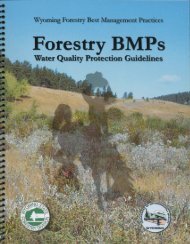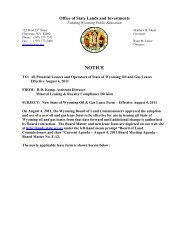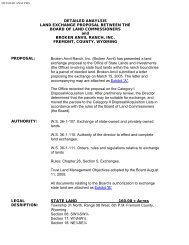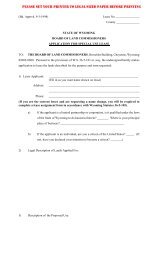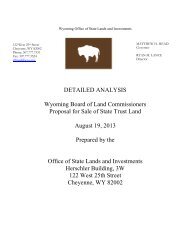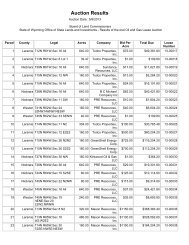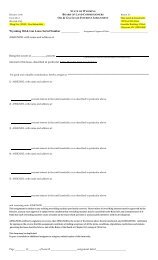wildland fire management annual operating plan big horn county ...
wildland fire management annual operating plan big horn county ...
wildland fire management annual operating plan big horn county ...
Create successful ePaper yourself
Turn your PDF publications into a flip-book with our unique Google optimized e-Paper software.
Keeping an approaching wild<strong>fire</strong> from reaching a structure may be the responsibility of any<br />
parties to this agreement depending upon the location of the wild<strong>fire</strong> and the chosen<br />
<strong>management</strong> strategy.<br />
Private Lands – Cost associated with the protection of privately owned land and structures<br />
are the responsibility of the local <strong>fire</strong> service entity that has jurisdiction for the private<br />
property.<br />
Federal Lands w/Private Structures - Costs associated with the protection of privately<br />
owned structures on federal lands are the responsibility of the local <strong>fire</strong> service entity that has<br />
jurisdiction for the private structures. Structure protection responsibilities of the local <strong>fire</strong><br />
service entity include actions taken directly on the structure or the immediate area surrounding<br />
structure. The federal agencies will be responsible for costs associated with keeping the <strong>fire</strong><br />
from reaching the structures.<br />
Agencies that elect not to suppress an ignition with intent to manage the <strong>fire</strong> for resource<br />
benefits are responsible for the cost associated with that <strong>fire</strong>. This includes the cost of<br />
protecting private land, structures and infrastructure, as well as other State and Federal<br />
managed lands, unless negotiated otherwise with the other affected jurisdictions. For<br />
incidents that have an initial response objective of protection (suppression) and it is later<br />
determined that there is also an opportunity to effectively manage a portion of the incident for<br />
resource benefit objectives, agencies should follow the standard cost share principles and<br />
may need to develop additional cost share agreements based on changes in the situation and<br />
objectives.<br />
The local <strong>fire</strong> service entity is responsible for developing structure protection <strong>plan</strong>s and<br />
coordinating with the incident <strong>management</strong> team to implement the <strong>plan</strong>. This could include<br />
the local <strong>fire</strong> service entity preparing the <strong>plan</strong> themselves or working with the incident<br />
<strong>management</strong> team to obtain resources to prepare and implement the <strong>plan</strong>. The local <strong>fire</strong><br />
service entity is responsible for determining any actions to be applied directly to a structure<br />
such as wrapping; applying foam, <strong>fire</strong> gels, or other retardants; sprinklers on roofs, etc.<br />
2. RADIO FREQUENCIES<br />
Communication frequencies to be used for initial attack:<br />
Rx freq Rx CG Tx freq Tx CG<br />
North Zone WY Fire Zone<br />
BLM –Base Channel 168.525 168.525<br />
Scene of Action 166.0875 166.0875<br />
Cedar Mountain Rpt 168.525 172.4375 123.0<br />
Black Mountain Rpt 168.525 172.4375 110.9<br />
Wyoming State Forestry 151.160 151.160<br />
Fire 154.280 154.280<br />
USFS - Big<strong>horn</strong> Forest (NW) 170.525 110.9 170.525 110.9<br />
10



